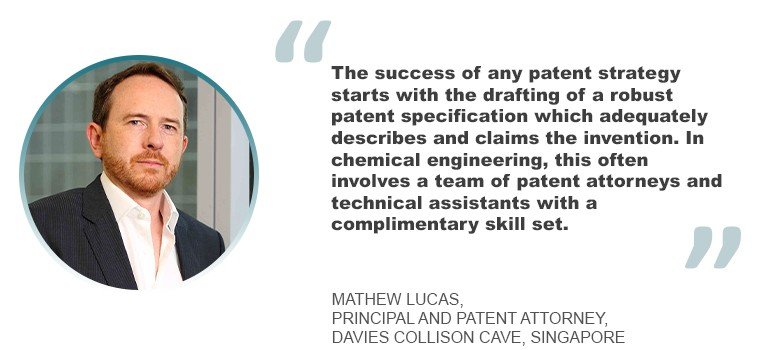How IP drives breakthroughs in chemical engineering
30 November 2023

The chemical engineering sector is increasingly focusing on sustainability and green technologies. Excel V. Dyquiangco discussesstrategies for safeguarding IP in this field, including the significance of patents and trade secrets, their advantages and challenges.
As global industries push the boundaries of science and technology, chemical engineers continue to develop groundbreaking solutions and products. However, protecting intellectual property rights is essential to incentivize and reward these innovative efforts. From pharmaceutical companies securing patents for life-saving drugs to renewable energy companies safeguarding their novel processes, the intersection of chemical engineering and IP has become a central theme in fostering innovation, economic growth and the well-being of society.
In 2021, Singapore’s system made changes as a resolution for IP-related disputes to simplify processes and facilitate the development of IP jurisprudence. These changes also introduced a new “fast track” option for IP proceedings, setting limits to trial duration, claim value and potential awarded costs. The intention is to cater to lower-value disputes or less well-resourced litigants across various sectors, not exclusively for chemical engineering.
Take, for instance, the Sunseap v. Sun Electric case, which revolved around competitors in the solar energy retail business and involved green energy that came before the Singapore courts in 2019. Sun Electric sued Sunseap for infringing its Singapore-patented power grid system and its method of determining power consumption at various connection points in the system. Sunseap denied the allegation of infringement and sought to invalidate the patent on the grounds of lack of novelty and inventive steps.
The decisions are interlocutory decisions relating to whether the High Court has the original jurisdiction to hear applications for patent revocation or to order that a patent be revoked. The position has since been settled by legislative amendment, giving the High Court concurrent jurisdiction with the Intellectual Property Office of Singapore (IPOS) to hear applications for patent revocation.
Meanwhile, about 90 percent of all patent filings in Australia are from foreign applicants. In 2022, IP Australia recorded over 32,000 patent applications, with the U.S., China, Japan, the UK and Germany as major contributors. Over the past decade, a consistent trend in patent filings within chemical engineering involves new industrial processes in mining, energy and agricultural fields.
Protecting innovations in the chemical engineering space
So, with the increasing focus on sustainability and green technologies in the chemical engineering sector, what strategies are recommended for protecting IP rights in innovations related to green energy and biofuels, considering the diverse regulatory landscape in the Asia-Pacific region?
According to Pin-Ping Oh, a partner at Bird & Bird in Singapore, the protection of innovations in but not limited to the green sector primarily revolves around two approaches: patents and trade secret protection. However, she cautioned that both have pros and cons.
Oh explained that while patents grant monopoly rights even if the infringer independently developed the technology, the protection lasts only 20 years. Trade secrets provide potentially indefinite protection but do not protect against independent development. Moreover, safeguarding relies on maintaining the information’s secrecy.

“Therefore, the choice between patents or trade secret protection will depend on several factors,” said Oh. “This includes how easily the technology could be recreated or reverse-engineered by others, and the extent to which trade secrets need to be shared with third parties, as that will increase the chances of inadvertent confidentiality-destroying disclosure. These are technological and operational concerns.”
As for the regulatory landscape, some things to think about are that IP enforcement systems in certain countries in the region might not be advanced, affecting the availability of preliminary injunctions to stop infringement. Additionally, judges might lack technical training, making it harder for them to decide on patent infringement claims, particularly in highly specialized technical fields.
Meanwhile, Mathew Lucas, principal and patent attorney at Davies Collison Cave in Singapore, listed two IP considerations and challenges specific to this industry: establishing the right team and strategizing for commercialization.

“The success of any patent strategy starts with the drafting of a robust patent specification which adequately describes and claims the invention,” he said. “In chemical engineering, this often involves a team of patent attorneys and technical assistants with a complimentary skill set.”
He also highlighted the interdisciplinary nature of chemical engineering, which requires a diverse skill set such as physics, materials science, mathematics, chemistry and process engineering. To craft robust patent strategies, a technologically competent team comprising patent attorneys and technical assistants with advanced degrees in relevant disciplines is essential.
Regarding commercializing chemical engineering innovations, various strategies and potential pitfalls come into play: choosing between patent filing and trade secrets, timing and overseas patent filing strategies.
“Much of the innovation, which takes place in mining processing technology, involves optimization and yield improvements,” he said. “Even small improvements to existing mining technologies can provide substantial rewards in capital expenditure, operating expenditure and overall yield and profitability.”
According to Lucas, if the product of the improved process does not change, there’s potential to safeguard these enhancements as trade secrets instead of pursuing a patent. This approach might suit big mining companies aiming solely for in-house technology advancement. However, this might not be the best strategy for research and development (R&D) groups planning to license the technology.
Moreover, filing a patent doesn’t automatically forfeit trade secret rights, but the opposite isn’t always the case. Lucas stressed the importance of well-drafted patent specifications serving as marketing tools while maintaining confidentiality when necessary. Should the technology be licensed or assigned, the patent application may be withdrawn before the patent is published.
Publication is made 18 months after filing. With this, Lucas emphasized the advantage of filing patents to retain options for patent and trade secret protection during this time frame.
Role of international agreements and treaties
Lucas, having worked in the ASEAN and Asia-Pacific region over the last 20 years, said many work-sharing programs are available to patent applicants to speed up the process. These initiatives include the Patent Prosecution Highway (PPH), the Global Patent Prosecution Highway (GPPH) and the ASEAN Patent Examination Cooperation (ASPEC). PPH and GPPH aim to accelerate patent examinations between IP Australia and foreign patent offices, while ASPEC uses the search and examination results from another participating IP office (the first IP office) as a reference.
Meanwhile, IP Australia’s Direct Expedited Examination, Subregulation 3.17(2) of the Patent Regulations, allows the Commissioner of IP Australia to speed up the examination if it’s in the public interest or if there are special circumstances.
Lucas also added that there is a potential strategy for reviewing patents related to green technology. Despite IP Australia providing no specific definition of what constitutes ‘green’ technology, he underscores its broad scope within chemical engineering. This includes areas such as biofuel production, biomass processing, biodegradable plastic manufacture, fuel cell development, hydrogen storage technology, and processes leading to reduced capital expenditure and operational expenditure (CapEX and OpEX as optimized manufacturing processes).
Further, Oh added insights regarding international agreements and treaties, emphasizing their positive impact on securing IP rights across multiple nations and aligning standards of protection for registered and unregistered IP rights among member countries.
“Putting in place an IP management strategy would be a good start,” she said. This approach involves capturing and protecting innovations (via patents or as trade secrets), considering IP ownership in collaborative efforts or relationships, and addressing freedom-to-operate concerns.”






